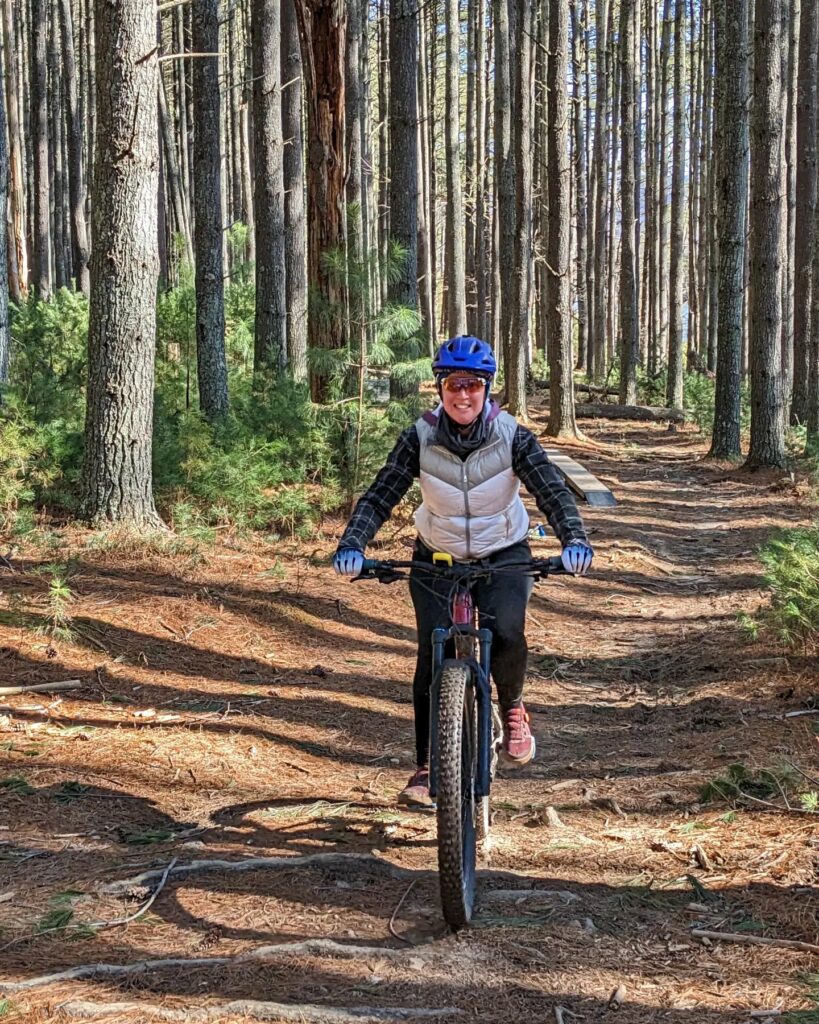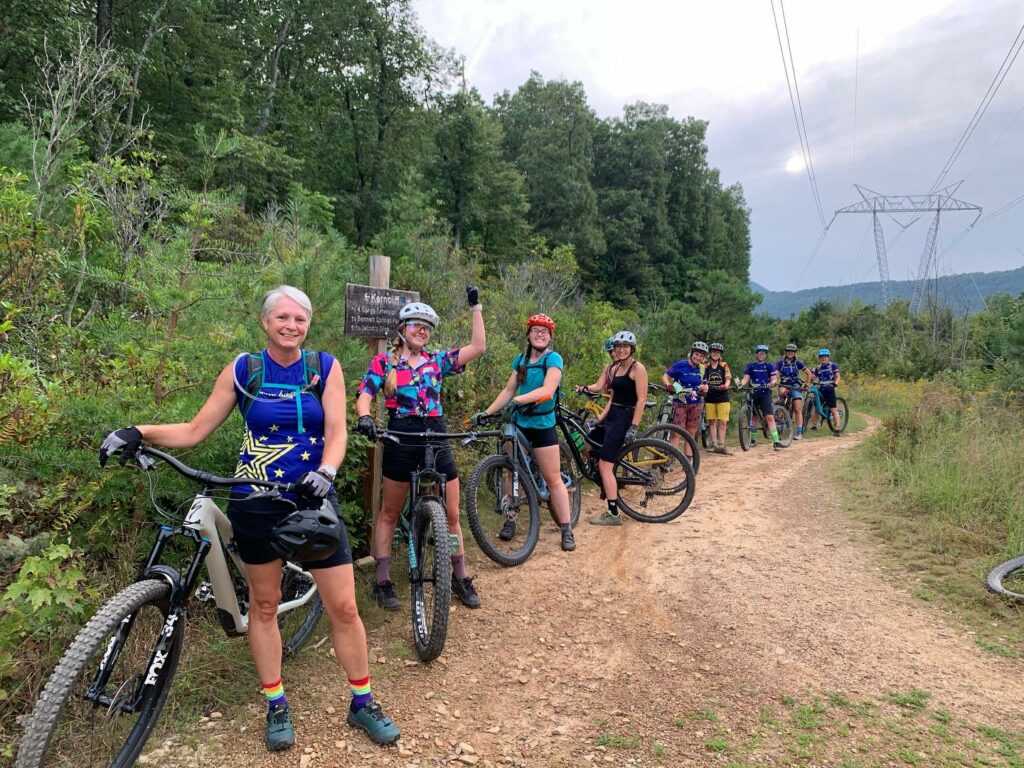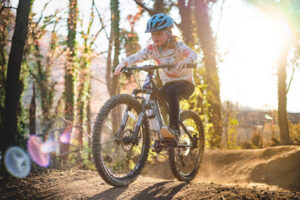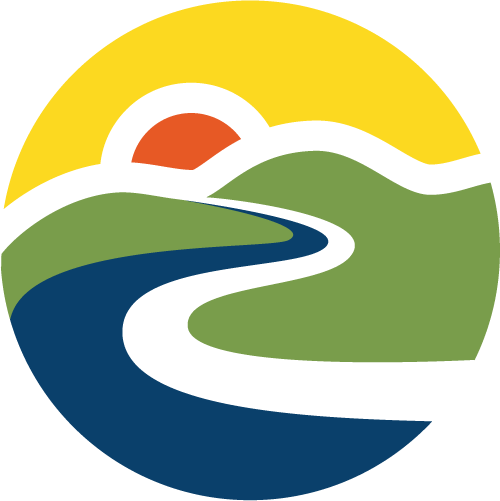
Getting Started Guide: Mountain Biking in the Roanoke Region
No matter how advanced we are at an activity, we were all beginners once! And being new to something can be a little daunting (especially in a sport like mountain biking). With our Getting Started Guides, we reach out to local outdoorsy folks who know what it’s like to be a beginner, and they’ve broken down how to start a new outdoor activity! Check out our Getting Started Guide: Mountain Biking in the Roanoke Region with Becky McKimmy, a local cyclist, member of Roanoke Valley Riveters, and community ambassador.

Becky McKimmy as she’s mountain biking the Enchanted Forest Trails at Carvins Cove in Southwest Virginia.
Gear: What do you need?
- A helmet: This is the most important item on the list. Protecting your head is vital.
- A bike: More information on this in a bit
- Clothing: A pair of shoes with a firm, grippy sole, shorts you can easily move your legs in, and a technical top.
- Water: Be sure to bring water on the trail. You can use a bike water bottle or a hydration pack. Hydration packs offer space to carry other items.
- Snacks: Every outdoor activity is better with snacks! Plus you’ll likely get hungry.
- First aid kit: You will fall over at some point. We all do it. So, having a first aid kit on hand is a good idea. A friend to help pick you up is also handy.
Other specialized gear & clothing like padded shorts, gloves, protective gear, and an activity tracker, are great if you have them, If not, don’t let that stop you from getting out there!

The Roanoke Valley Riveters pause their group ride for a photo.
What bike should I ride?
The are a lot of brands and styles of mountain bikes to pick from. If you are just getting started, renting a bike or borrowing a bike from a friend are good places to start. This will give you an opportunity to see if you enjoy mountain biking and what type of mountain biking you like before you make a purchase.
When picking a bike (borrowing, renting, or buying), make sure the bike is the right size for you and is in working order. Nothing is worse than being on a bike that is uncomfortable or that leaves you stranded in the woods. You don’t need to worry about things like suspension or wheel size when you are first starting.
If you decide you want to buy a bike, ride as many bikes as you can to get a feel for what you like. Local bike shops have a wide variety of bikes and would love to help you find one you love. A used bike is also a great option, and you can usually find those at Roanoke Mountain Adventures or Facebook Marketplace.
Where in the Region Should I Ride?
We are extremely lucky in Roanoke to have access to multiple great riding locations. Carvins Cove, Mill Mountain, and Morningside Park all have trails that offer varying levels of difficulty and styles of mountain biking. Carvins Cove has a little bit of something for everyone, and the gravel roads and lower trails are a good place for beginners. The trails on Mill Mountain all require some climbing and can be intimidating to new riders. Morningside and Vic Thomas parks are great places to work on skills or trying out a mountain bike for the first time. Local bike shops should have trail maps available, or you can look them up on websites like MTB Project and Trailforks.

Three mountain bikers ride at Enchanted Forest in Carvins Cove.
How can I find people to ride with?
There are a few options for finding people to ride with:
- Group rides: There are multiple group rides hosted by the local bike shops, clubs, and individuals. Group rides vary in difficulty, participant age, and accessibility to beginners. There also groups that cater to different subsets of riders, like the Roanoke Valley Riveters that provide a welcoming and empowering environment women to learn to ride. Be sure to check out the ride’s description before heading out. Details about group rides are usually available on social media, shop websites, or apps like MeetUp.
- Ride with a friend: One of the best ways to get started mountain biking is to go with a friend who is already a mountain biker. They can give you tips and tricks, know the local trail system, and might even have a bike you can borrow.
- Skills clinic: If you want to learn skills and best practices in a formal setting, going to a mountain bike clinic is a great option. There are clinics put on both near and far for all levels of riders. This is a good way to build confidence while you are learning.

Roanoke Valley Riveters on one of their Wednesday Night Rides.
What do I need to know before I hit the trail?
-
- Trail difficulty ratings: Mountain bike trails are labeled by difficulty on maps and/or trail signs. This helps you know what to expect on the trail. Beginner trails, usually marked by a green circle, are the easiest with minimal obstacles, small amounts of climbing, and no high-risk features. Intermediate trails, usually marked by a blue square, have a more varied surface, larger obstacles, and bigger climbs. Advanced trails, usually marked by a black triangle, have many obstacles and difficult features, some of which are unavoidable, and steeper, longer climbs.
- Don’t be afraid to walk: If something on a ride makes you feel uncomfortable or you are not able to complete it, there is no shame in walking. Everyone does it. Just remind yourself that everything is walkable.
- Look where you want to go: Your bike will follow your line of sight, so make sure you are looking where you want to be going. Keep your eyes ahead and past obstacles in front of you. You are more likely to run right into that rock in the middle of the trail if you stare at it.
- Trail Etiquette:
- The person going uphill has the right-of-way. Be sure to get off the trail so they can pass.
- Slow down when approaching people on foot or horses. Trails are often shared with different types of users, and people on foot or horses should be given the right-of-way to ensure everyone’s safety.
- Let others know you are coming. If you see a person a head of you, call out a friendly greeting to let them know you are coming. No one wants to be surprised by a fast (or slow) moving cyclist.
- Don’t ride on muddy trails. When the trails are muddy, you leave ruts that become permanent when the trail dries. If you are leaving tracks in the mud, it isn’t a good time to be riding. Try riding on gravel or a hard surface instead.

A young girl tries out the beginner mountain biking trail at Morningside Park.
Now that you’re armed with all the getting-started info you need–get out there! Follow us and share your beginner adventures with us by tagging Roanoke Outside. For more Getting Started Guides and all the outdoor info you can handle, sign up for our bi-weekly emails!

Create Your Own Land Adventure
Get Started
 Powered by Roanoke Outside
Powered by Roanoke Outside